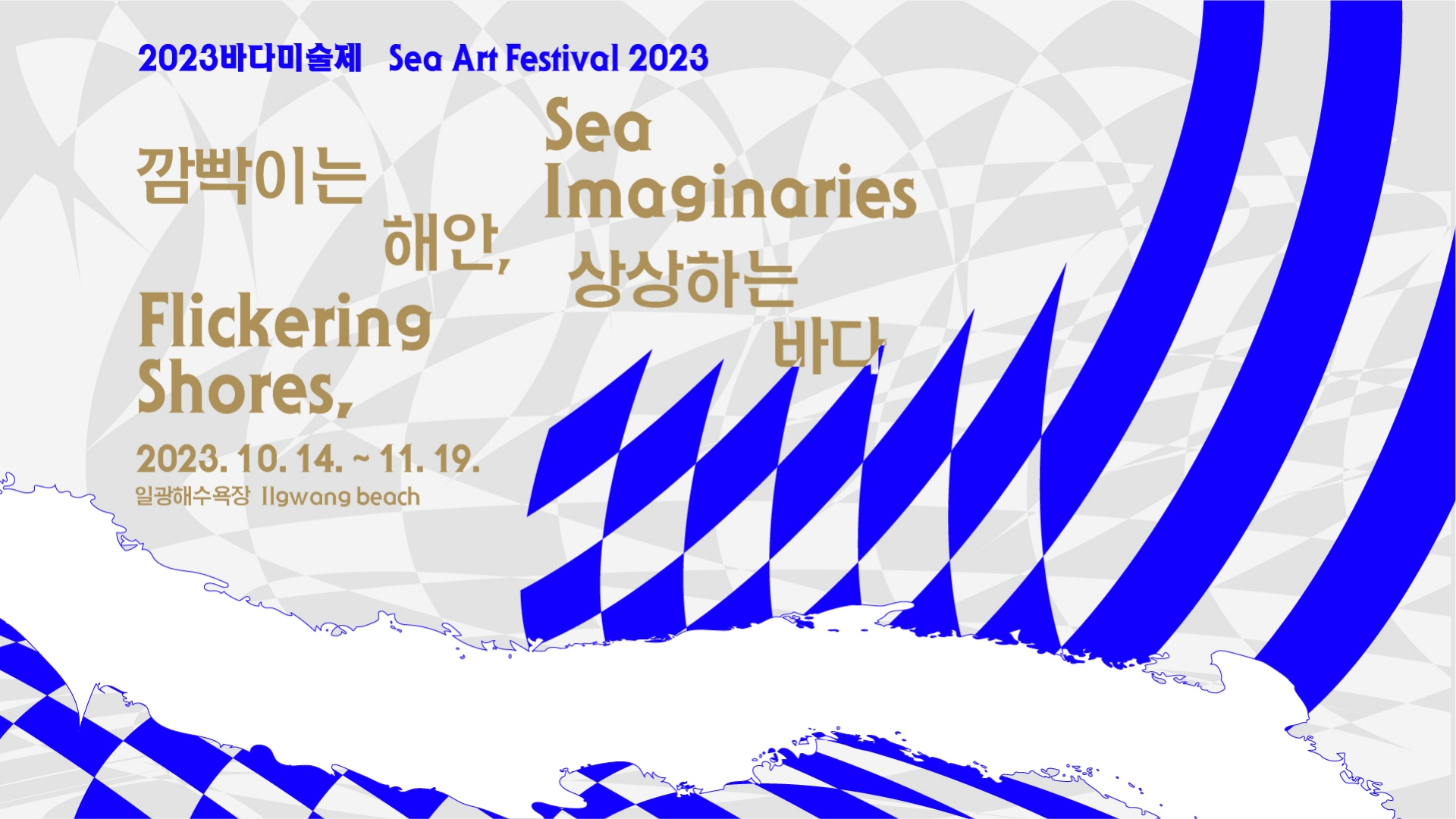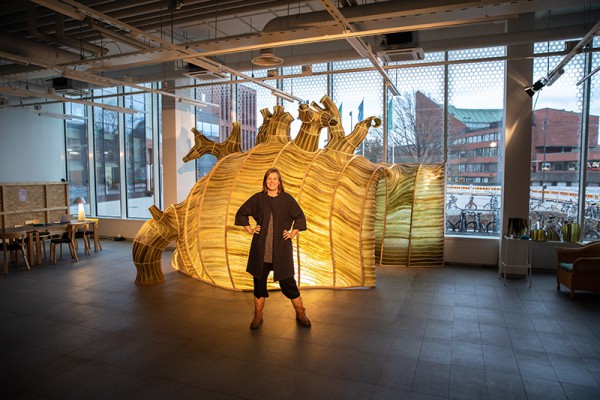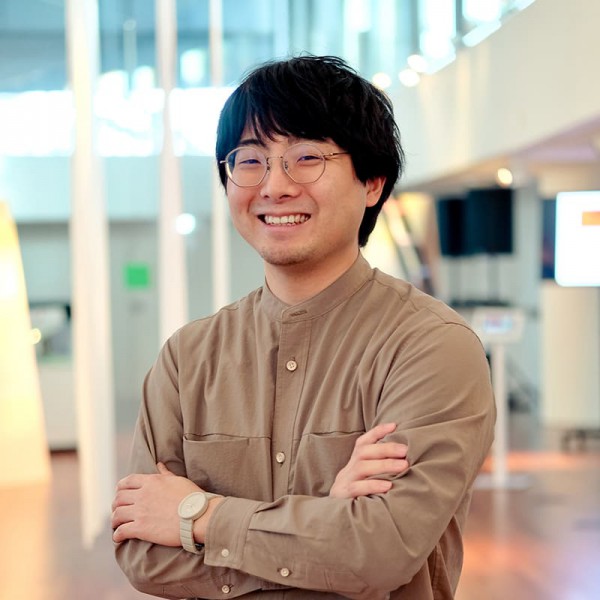


Flickering Shores, Sea Imaginaries, this year’s edition of the Sea Art Festival, is inviting us to rethink our relationship with the sea, referring to the beauty but at the same time, the fragility of our shores, and exploring alternative frameworks and visions for engaging with the ocean and marine environments.
The sea is deeply embedded in our lives and capitalist society, a vital source for our survival, but also a vast industry we exploit for food, medicines, energy, minerals, trading, travel and so on. But increased human activity, from extensive cruise tourism, shipping and overfishing to nuclear testing, pollution and deep-sea mining have been plaguing the sea, having a huge impact on marine ecosystems and habitats.

Instead of viewing the sea from the coast as a divided and abstract surface for moving around commodities, Flickering Shores, Sea Imaginaries reminds us that we are part of this body of water. This year's Sea Art Festival aims to explore new relationships with the sea and its ecologies, enabling spaces for cooperation, collective visions and synergies as a call to resistance and restoration.

Merilyn Fairskye lives in Sydney, Australia whose recent video and photographic work explores the effects of powerful events of real life on humans and the environment. Current projects that explore the relationships between technology, atomic landscapes, and community have taken her on location to the Polygon in Kazakhstan, Sellafield, Chernobyl, and other key nuclear sites. Her work has been presented at over 180 exhibitions and festivals, including at the Museum of Modern Art, New York, Tate Modern, London, the Stedelijk Museum, Amsterdam, the Museum of Contemporary Art, Sydney, and the Art Gallery of New South Wales.
VIEW MORE 
Félix Blume is a sound artist and engineer using sound as a basic material in sound pieces, videos, actions, and installations. His work is focused on listening and inviting viewers to a different perception of their surroundings. His process is often collaborative, working with communities and using public space as the context within which he explores and presents his works. Blume has participated in international festivals and exhibitions such as Thailand Biennale, Tsonami Arte Sonoro, CTM Festival, Berlin International Film Festival, International Film Festival Rotterdam, LOOP Barcelona, The Belluard Bollwerk, and Sonic Acts.
VIEW MORE 
Ari Bayuaji was born in Indonesia in 1975 and immigrated to Canada in 2005. Dividing his time between Montreal and Bali, the artist is known mainly for his art installations, which incorporate found and ready-made objects from different parts of the world, thereby exposing himself to the different mechanisms of cultures. In almost all his artworks, Bayuaji has consistently used found/old objects from around the world as the material and subject matter. He is an expert in conveying aspects of daily life, as his works usually try to show the overlooked artistic value in everyday life through objects and places, and their roles within society.
VIEW MORE 
Rebecca Moss’s artistic practice explores notions of absurdity, precarity, and instability, and takes a variety of forms across different media. She is drawn to slapstick for its sense of reciprocity inasmuch as our surroundings can act back upon us because we are not always in control. She is inspired by slapstick performances and creates scenarios that stage interactions between human gestures and elemental forces, where an idea or gesture is humorously played out to the point of futility, chaos, or crisis.
VIEW MORE 
Gary Zhexi Zhang explores connections between cosmology, technology, and the economy. He is the editor of Catastrophe Time!, a book of financial fiction. Dead Cat Bounce, an oratorio he made with Waste Paper Opera, premiered in 2022. His last solo show, Cycle 25, documented events at the boundaries between speculative belief and the material world, like natural disasters, scam nations, and cosmic economies. His work has been shown at the Venice Architecture Biennial, the Power Station of Art, Shanghai, and Para Site, Hong Kong. Upcoming commissions will be presented at the Art Gallery of York University, EPFL, Lausanne, and Eastside Projects, Birmingham.
VIEW MORE 


Have you ever looked closely at a grain of sand? Imagined it as a small part of the world, with its very own story to tell?
The journey of a grain of sand has been guided by water, wind, and ice over time. Just like people, each grain has its own character and tells a unique story of the land and history. It is also one of the most important materials in our lives. Without it, we would have no glass, no computer chips, and no buildings.
To See a World in a Grain of Sand is a project that maps the Earth through small sand samples contributed by people worldwide, revealing hidden narratives embedded in glass fused from 'wild' sands. From a hot and dry desert to a cold and snowy mountain; a skyscraper in a bustling city to an archaeological ruin; an invisible political border to a vast and open landscape; an excavated gold mine to the bottom of an ancient seabed; or a place of civil unrest to a serene holiday island. When these geographical diversities become visible, it becomes clear that sand carries not only ecological significance but powerful social and political histories.
Specially curated for the Sea Art Festival, Atelier NL delves into South Korea's history. In the intricate tapestry of our planet's story, sand stands as a silent witness to the passage of time, shaped over billions of years. Yet, this seemingly abundant resource faces an urgent global crisis - a scarcity driven by insatiable demand.
Every year, we remove billions of tons of sand from beaches, rivers, oceans, and quarries across the planet, locking it away in infrastructure and technology. This makes sand one of the most quickly disappearing natural resources in the world, so much that there is now a global sand scarcity.
Amidst these global challenges, South Korea stands at a crossroads. As a rapidly growing nation, it must strike a delicate balance between ambitious development plans and safeguarding the environment. Busan's skyline of towering skyscrapers showcases the magnitude of sand's role in construction. It serves as a poignant reminder that sustainable sand management is crucial to support the city's growth while preserving the natural beauty that surrounds it. This installation invites you to see the world anew, where the humble grain of sand carries stories of our past, present, and future.
The collected sands, mainly gathered by Bora Hong, a multidisciplinary designer from Seoul now residing in Chiang Mai, are visualized on the map of South Korea. During her 10-day road trip, she collected sands from diverse beaches along the coastline. Exploring rivers and little streams led her to unexpectedly beautiful and tranquil locations. Bora's involvement with "aworldofsand.com" allowed her to uncover sands with profound stories and memories reflecting the country's rich cultural heritage and natural beauty.
Alongside Bora's captivating journey, Atelier NL categorized each story and place into six themes: history, migration, meaning, ecology, delay, and scarcity, providing a unique perspective on the sands' significance and the memories they evoke.
VIEW MORE 
Would you adapt your body to “serve” marine ecosystems and keep aquatic organisms healthy?
How to Become Wholesome investigates how bodily waste, in the broadest sense (tears, sweat, and urine), may contribute towards the wellbeing of aquatic organisms.
Extending from Kasia’s renowned installation How to Make an Ocean, where the artist collected and analyzed the chemical composition of human tears in order to feed tiny marine ecosystems, this work poses a series of questions such as: How to care for one's own body so that it becomes the most nutritious for a marine ecosystem? What tools are needed to harvest those nutrients from the human body? How do we test harvested substances for their suitability? What are the aesthetics of this process and of developing connections between the human body and the ocean?
The ongoing research behind this project is presented in a series of records and tools. Diet diaries and records of the chemical composition of Molga’s bodily secretion (Records of Transforming into Resource); a series of sketches of tools for helping to harvest nourishment from bodily waste (Tools for Harvesting Nourishment); and invented for purpose lab instruments.
Most importantly, at the heart of the current edition of this installation, are 3 to 4 interconnected water tanks. In these tanks, water made out of various bodily sources mixes with seawater, influencing the growth and nourishing the development of specially selected aquatic plants.
How to Become Wholesome draws a parallel between the wellbeing and survival of the human body with that of non-human species and reminds us that we are very much part of nature and the ocean, not a separate entity.
VIEW MORE 
Echo, Filled in the Sea is an installation in the shape of a net that spans 8 meters in width and 4 meters height. The net is created based on stories of local residents. It is intricately woven with pearls and beads. The round and luminous pearls symbolize precious moments, emotions, and memories. Additionally, the arrangement of pearls, along with elongated beads, form Morse code messages, encoded text characters in sequences of signal durations. Each pulse of the Morse code represents a message written for someone close, who can no longer be here — a message for someone from the past and long gone.
The net is suspended above the beach, swaying freely at the boundary between the sea and the sky. It reaches out toward the distant sea, a symbol of longing, as delicate strands of the net are intertwined like outstretched hands.
The hidden voices within the encrypted messages in the delicate threads of the net yearn to reach the souls of those who are no longer by our side, while reminding us that the sea is a place of hardship and precariousness for many people. As we gaze upon the transparent glow of pearls and beads, we offer a prayer that they might echo back to us.
VIEW MORE 
What if we were able to transform immense quantities of plastic objects found on our shores into valuable material?
Traces of the Waves is a new art installation, which forms part of the artist’s ongoing Weaving the Ocean art project series. In this project series, artist Ari Bayuaji transforms plastic waste into textile art, often made in collaboration with artisans.
The site-specific installation, created for this year’s Sea Art Festival, and situated alongside the wooden pathway next to Ilgwang Beach, has been constructed using thousands of plastic threads unraveled from plastic ropes found on beaches and the coast in Bali (Indonesia), as well as found plastic objects gathered from shorelines in Busan (South Korea).
Colorful plastic ropes, which are used for fishing nets, are often found washed up on our coastlines across the world in large quantities. Many times, they are entangled with marine life such as corals, or wrapped around vegetation on the beaches and beyond. But apart from plastic ropes, every year, we produce and consume over 400 million tons of plastic. From these plastic objects, we consume and throw away, about at least 14 million tons end up in the ocean every year, being carried away across the waters. Many of these plastic objects end up along our shorelines and plastic makes up almost 80% of all marine debris, from sea surface waters to deep-sea sediments.
Traces of the Waves addresses pressing environmental and social issues such as the immense pollution of our oceans and its consequences, the destruction of marine life, and the loss of the coastlines’ natural beauty. Bayuaji - working in collaboration with communities and artisans - goes through a meticulous process of collecting little by little plastic ropes and other plastic objects found on the beach, washing these materials several times, and separating them until they are transformed into usable fine threads that can be woven into textiles or used in his art installations such as this one.
This long process becomes a collaborative, caring and conciliatory effort that transforms an insignificant and cheap plastic object that pollutes our waters, giving it a new life as a useful and valuable artistic material. A devastating and negative impact on the environment becomes a “positive” outcome, drawing on collectivity and common endeavor, while celebrating craftsmanship. At the same time, Bayuaji pays homage to his Indonesian culture and textile traditions, but also the importance and role of the sea, which is right to the center of Balinese culture, philosophy, spirituality and rituals.
As one walks through the Traces of the Waves path, colorful strands and tufts of plastic threads can evoke forms of marine creatures like jellyfish and corals or the feel of seaweed strands and sea grasses moving in the waters.
VIEW MORE 
The entire world’s economy rests on the shipping industry. The majority of things that countries produce or use every day – consumer goods, wheat, rice, oil, wood, coal – are moved around the world on cargo ships that grow more and more massive every year. Most of these ships are powered by heavy fuel oil (HFO), a dirty fuel formed from the residual (and therefore cheaper) product left over from petroleum refining. All this HFO leaves its traces across oceans and waterways across the world.
One response to this within the maritime sector is to build ‘greener’ ships that run on ‘greener’ fuels. Over the coming years, Busan’s shipyards will be hard at work building a new fleet of ‘green’ ships that run on alternative fuels such as methanol and hydrogen. Once built, many of these ships will run across what are called ‘green corridors’, bilateral agreements formed between two ports around the world, to plan for the green transition in shipping, secure the supply of ‘green’ fuels and the new infrastructure for refueling ships.
This research film by Liquid Time remotely follows the course of one cargo ship sailing from Rotterdam to Singapore, down one of the world’s largest proposed green corridors. Through a series of conversations held over the course of the 30-day voyage, this work examines the production of the image of the shipping industry’s green future, looking at the legal, economic and infrastructural basis for a green transition that, although promised, remains a distant prospect.
Peeling back the layers of regulation and economic planning that constitute the green corridor, Liquid Time show how the industry response to the climate crisis is not one based on radically altering current markets away from destructive tendencies, but generating new markets within which the same business-as-usual processes that drive the world economy can play out.
VIEW MORE 

포레스트 커리큘럼은 남아시아와 동남아시아를 잇는 삼림지대 조미아의 자연문화를 통한 인류세 비평을 주로 연구합니다. 작품 유랑하는 베스티아리는 이 연구의 일환으로, 비인간적 존재들이 근대 국민국가에 내재된 계급적이고 세습적인 폭력과 그에 따른 잔재들에 어떻게 대항해왔는지를 보여주는 작품입니다. 좌중을 압도하는 듯한 거대한 깃발들은 위태롭고도 불안하게 스스로를 지탱하고 있는 듯 보입니다. 깃발에는 벤조인이나 아편부터 동아시아 신화에 등장하는 동물들까지 비인간 존재들을 상징하는 대상들이 그려져 있습니다. 각 깃발들은 비인간적 존재들의 대표자로서 모두가 한데 결합되어 아상블라주 그 자체를 표상합니다. 또한 깃발들과 함께 설치된 사운드 작품은 방콕과 파주에서 채집된 고음역대의 풀벌레 소리, 인도네시아의 경주용 비둘기들의 소리, 지방정부 선거를 앞두고 재정 부패를 유지하기 위한 수단으로 쓰이는 불필요한 공사에서 발생하는 소음, 그리고 위의 소리들을 찾아가는데 사용된 질문들과 조건들을 읽어 내려가는 내레이션으로 이루어져 있습니다.




